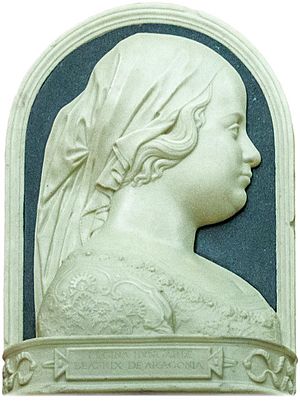Beatrice of Naples facts for kids
Quick facts for kids Beatrice of Naples |
|
|---|---|
 |
|
| Queen consort of Hungary and Bohemia | |
| Tenure | 1476–1490 |
| Coronation | 12 December 1476, Székesfehérvár |
| Tenure | 1491–1502 |
| Born | 16 November 1457 Naples |
| Died | 23 September 1508 (aged 50) Naples |
| Spouse | Matthias Corvinus Vladislaus II of Hungary |
| House | Trastámara |
| Father | Ferdinand I of Naples |
| Mother | Isabella of Clermont |
Beatrice of Naples (born 16 November 1457 – died 23 September 1508) was an important queen in European history. She was also known as Beatrice of Aragon. She became Queen of Hungary and Bohemia twice through her marriages. Her first husband was Matthias Corvinus, and her second was Vladislaus II. Beatrice was the daughter of Ferdinand I of Naples and Isabella of Clermont.
Contents
Early Life and First Marriage
Beatrice grew up in Naples, a city in Italy. She received a very good education at her father's royal court. This meant she learned many important things that helped her later as a queen.
In 1474, Beatrice became engaged to Matthias Corvinus, the King of Hungary. They were married in Hungary on 22 December 1476. Soon after, she was crowned Queen of Hungary in a special ceremony in Székesfehérvár.
A Royal Alliance
Beatrice's marriage helped create a strong friendship between Hungary and Naples. This alliance was important for both kingdoms. For example, when an army from the Ottoman Empire attacked the city of Otranto in Naples, King Matthias sent help. His general, Blaise Magyar, helped take back the city in 1481.
Beatrice was not just a queen; she also had a say in how Hungary was run. She was very interested in the Renaissance, a time of great art and learning in Italy. She brought many new ideas from Italy to the Hungarian court.
Cultural Influence and Royal Projects
Beatrice shared her love for learning and art with King Matthias. She encouraged him to expand his famous library, the Bibliotheca Corviniana. This library was one of the largest and most important in Europe at the time.
She also helped build the beautiful Visegrád Palace, which became a grand home for the royal family. Beatrice even helped create an academy, a special school for learning. She wanted to be involved in important decisions. She joined Matthias during a trip to Austria in 1477. She was also present when Matthias and Vladislaus II signed a peace treaty in 1479.
Challenges and Second Marriage
Later in their marriage, things became difficult between Beatrice and Matthias. Matthias had an illegitimate son named John. He wanted John to be his heir, which meant John would take over as king after him. Beatrice did not agree with this plan.
When King Matthias died in 1490, Beatrice worked hard to keep her position as queen. She had the support of many important Hungarian nobles. They wanted her to remain queen, so they supported her marriage to the next king.
A New King and a Disputed Marriage
The Hungarian nobles asked Vladislaus II of Bohemia and Hungary to marry Beatrice. Vladislaus was already King of Bohemia and soon became King of Hungary. Beatrice married him in 1491. This marriage, like her first, did not result in any children.
However, there were questions about whether this marriage was truly legal. Vladislaus had been married before, and he had not received a proper divorce from the Pope. Vladislaus himself claimed he was forced to marry Beatrice and did not think their marriage was valid.
In 1493, a special group was formed to look into the marriage. Finally, in 1500, the Pope declared that Beatrice's marriage to Vladislaus was not legal. Beatrice had to pay for all the costs of this legal process.
Later Life and Legacy
After the marriage was declared illegal, Beatrice returned to her home city of Naples in 1501. Vladislaus was then free to marry Anne of Foix-Candale in 1502. Beatrice lived in Naples until her death on 23 September 1508.
Beatrice of Naples played a significant role in Hungarian history. She brought new ideas and culture from the Italian Renaissance to Hungary. She was a strong queen who tried to influence politics and supported learning and the arts.
See also
 In Spanish: Beatriz de Nápoles para niños
In Spanish: Beatriz de Nápoles para niños

